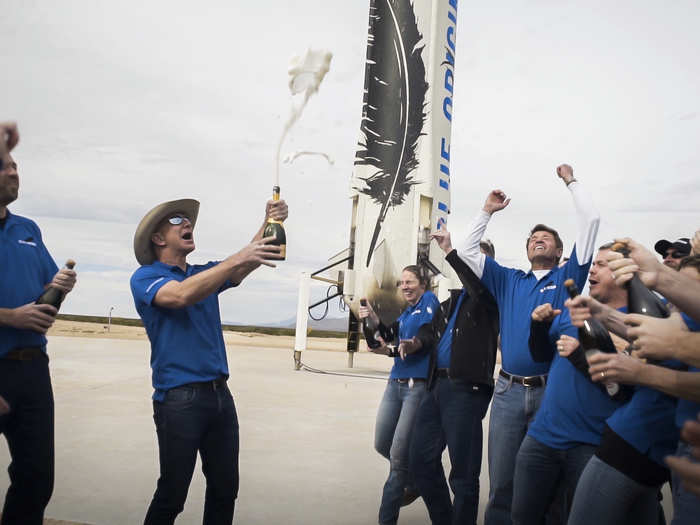
The Blue Origin team celebrates with founder Jeff Bezos at the site of the New Shepard rocket booster landing (Source: BlueOrigin)
Rumours of Amazon planning a “big, audacious space project” were confirmed when GeekWire spotted plans for Jeff Bezos’ Project Kuiper among public filings by Kuiper Systems LLC in Washington DC.
An Amazon spokesperson confirmed the developments stating, “Project Kuiper is a new initiative to launch a constellation of low Earth orbit satellites that will provide low-latency, high-speed broadband connectivity to unserved and underserved communities around the world.”
Amazon may have made a massive investment — the exact numbers of which are still unknown — but it’s one of the last entrants in the space race to provide universal connectivity.

SpaceX successfully launched the PAZ satellite the Vandenberg Air Force Base in California carrying SpaceX’s first two Starlink demonstration satellites to orbit (Source: SpaceX)
Elon Musk, the prolific billionaire behind SpaceX, has already received the go-ahead to launch 12,000 satellites to form a satellite based constellation called Starlink, which Musk describes as, “rebuilding the Internet in space.”
Two prototypes test flights have already been conducted in 2019 and the first set of satellites are scheduled to take off in 2019.

Google’ CEO, Sundar Pichai (Source: BCCL)
Google is one of the fiercest advocates of universal accessibility to the internet — something they’re already trying to accomplish by providing free Wi-Fi at railway stations across India.
Even though its plans to build a satellite constellation are considerably smaller with only 1,000 satellite actually going up in space. The rest of the broadband network will be managed using ground stations.
The satellites will be arranged in two layers — covering 75% of the Earth — so that even if one satellite is temporarily inactive, another can pull the load.

The successful launch of OneWeb’s the first satellite in its plan to deliver global connectivity (Source: OneWeb)
OneWeb also has a plan to put 600 satellites into orbit in order to serve the ‘digital deserts’ of the world by 2021.
After successfully launching its first satellite on February 27, the company was able to secure an additional $1.25 billion in funding for its satellite constellation.
Although OneWeb may be less ostentatious that its competitors, it has the first mover advantage in a market that’s growing increasingly competitive.
According to the company’s mission, universal access isn’t just about making sure that the internet is available to everyone but also that it’s affordable.

Telesat President, Dan Goldberg (center) with the richest man in the world, Jeff Bezos (left), and CEO of Blue Origin, Bob Smith (right) (Source: Telesat)
Telesat wants 300 satellite pace in low Earth orbit (LEO), which is approximately 2,000 kilometers above the Earth, by 2022.
In fact, it will be using rockets from Jeff Bezos’ Blue Origin in order to launch its satellites into space. And the constellation’s network operating system is being designed by Google’s parent company, Alphabet.
According to the company, their plans for Phase 1 of the project is complete and that they will soon be conducting demonstrations and live testing.
 8 seeds that boost your brain health
8 seeds that boost your brain health
 India to witness a rare and mesmerising DOUBLE meteor shower on July 30!
India to witness a rare and mesmerising DOUBLE meteor shower on July 30!
 Apple to manufacture iPhone 16 Pro models in India soon after launch
Apple to manufacture iPhone 16 Pro models in India soon after launch

Copyright © 2024. Times Internet Limited. All rights reserved.For reprint rights. Times Syndication Service.